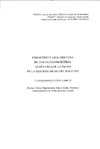Identificador persistente para citar o vincular este elemento:
https://accedacris.ulpgc.es/jspui/handle/10553/56180
| Título: | Urbanismo y arquitectura de una ciudad marítima: Santa Cruz de la Palma en la segunda mitad del siglo XVI | Autores/as: | López García, Juan Sebastián | Clasificación UNESCO: | 620103 Urbanismo | Palabras clave: | Renacimiento Santa Cruz de La Palma Canarias Urbanismo Ciudad marítima, et al. |
Fecha de publicación: | 2014 | Publicación seriada: | Tebeto: Anuario del Archivo Historico Insular de Fuerteventura | Resumen: | Santa Cruz de La Palma fue fundada con posición costera en 1493, en el momento de finalización de la conquista de la isla de La Palma. Emplazado en el enclave de Tinibucar, cantón de Tedote, el primer asentamiento ocupó un promontorio del lado norte en la desembocadura del barranco de Las Nieves, en la zona de Carías-La Encamación, pero fue sustituido por otro, al sur del barranco de Los Dolores, donde se desarrolló la ciudad definitiva. Su perímetro se desplegó de forma alargada en paralelo a la costa, con una adaptación a Ja topografía del lugar, que impuso una parte baja más llana y otra más alta en pendiente. En consecuencia, la ciudad se constituyó con dos tipos de trazado, uno de tendencia regular en el primer nivel y otro irregular en el segundo. Santa Cruz de La Palma estaba consolidada en la segunda mitad del siglo XVI con un perfil de ciudad portuaria de carácter comercial, cabecera insular administrativa y religiosa, que era a la vez la plaza fuerte más importante de la isla. En este período se construyeron los edificios más notables, que tienen en el Templo de El Salvador, antiguo Cabildo y fuente, el mejor conjunto renacentista del archipiélago. En sus características contiene muchas similitudes con las ciudades canarias del momento, pero también tiene paralelismos notorios con urbes portuguesas del ámbito macaronésico en cuanto a su urbanismo y su arquitectura. Santa Cruz de la Palma was founded in a coastal position in 1493, at the end of the conquest of the lsland of La Palma. The first settlement, in the enclave ofTinibucar, canton ofTedote, occupied a promontory at the northem side of the mouth of the barranco of Las Nieves, in the area of Canarias-La Encamación; but this first settlement was substituted for another one to the south of the barranco of Los Dolores, where the city finally developed. lts peri meter took a long shape parallel to the coast, adapting itself to the local topography which imposed a lower flatter part oftown, anda higher steeper si de. It is argued that as a consequence ofthis, the town grew with two types ofpattem, one with a regular tendency for the first level, and another irregular one for the second. Santa Cruz de la Palma was consolidated in the second halfofthe l61h Century with the profile of a commercial harbour town, the religious and administrative head of the island but also its most important stronghold. It was during this period that its most prominent architecture was built: the Templo del Salvador, the Old Cabildo and the fountain which together make up the best renaissance set ofbuildings ofthe whole archipelago. Santa Cruz de la Palma shares many a characteristic with other canary towns of the same time, but it also shows notorious parallelisms with Portuguese towns ofthe Macaronesia regarding its urban planning and architecture. |
URI: | https://accedacris.ulpgc.es/handle/10553/56180 | ISSN: | 1134-430X | Fuente: | Tebeto: Anuario del Archivo Histórico Insular de Fuerteventura [ISSN 1134-430X], n. 7, p. 19-42 | URL: | http://dialnet.unirioja.es/servlet/articulo?codigo=6241931 |
| Colección: | Artículos |
Visitas
140
actualizado el 10-ago-2024
Descargas
114
actualizado el 10-ago-2024
Google ScholarTM
Verifica
Comparte
Exporta metadatos
Los elementos en ULPGC accedaCRIS están protegidos por derechos de autor con todos los derechos reservados, a menos que se indique lo contrario.
